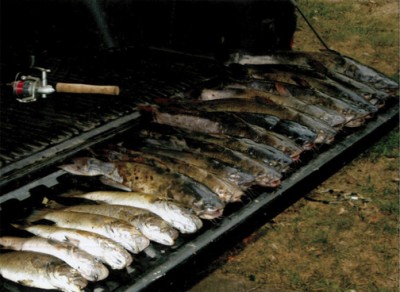Small Waters for Smallmouths
Josh Wolfe 07.18.13

The cast net forms a fluorescent sphere below the eddy as it flays the water, creating tiny rainbows in its mist. Leatherhead minnows scatter to and fro as Lyle gives the net a sharp jerk and pulls it toward us. Slim forms shake vigorously as we pluck them loose, falling to the bank before pitching them into the flow-troll minnow bucket. We sit coolly down by the river, the heat of the day hovering above us as we gather our gear and begin the walk upstream in search of smallmouth bass.
As many anglers know, smallmouth bass are about the hardest fighting of the freshwater fish. Pound for pound, they pull like a bulldog on a hobbled flank steak, providing ample fun. Searching for them in smaller rivers and creeks is usually one of the best parts, especially in the dead of summer when the scorching sun makes it too hot to touch an aluminum boat on the open water. At least wade-fishing provides natural air conditioning in the cool, flowing current, and you’re in the water the whole time.
From where Lyle and I usually park, it’s a mile walk upstream to our favorite holes. Of course, we catch our minnows at the start, the river always giving them freely, and even hit a few holes around the “landing” area for a supplemental fish or two. The pylons of the bridge of the highway that crosses the river will generally house a few, a nice warm-up for the fun to come.
One of the most important pieces of equipment to carry is a backpack. My initial inclination is to mention a cast net, rods, and hooks–obvious essentials–but without a pack on your back, where would you carry all that stuff? Plus, you’ll need to tote water, hopefully a stringer, and maybe even a celebratory beer or two for when the day is through.
Our general “gear guide,” if you will, includes medium-action spinning rods with 10-pound mono line, 1/0 hooks, split shots (for the deep holes and swift water), a five-foot, 1/4-inch mesh cast net, a flow-troll minnow bucket (with attached rope to haul), polarized sun glasses, and the aforementioned backpack. Obviously, you’ll need good water shoes, a bathing suit, and a dab of sunscreen on the nose doesn’t hurt.
As we slowly move upriver, we cast to midstream grass beds and underwater rock structures–always throwing from the downstream side, as many fly-fishing techniques apply. The river we generally fish, which is somewhere between Mobile, Alabama, and Green Bay, Wisconsin, is no more than 30 yards across at its widest expanse. We know the hot spots where we’re sure to catch fish, but are always seeking out the unknown, never leaving any stone unturned.

As usual, Lyle catches the first fish of the day. Mine comes shortly thereafter. The hit is hard and I can feel the jolt of my bucking rod in my excited hands, even as they slap the keyboard to write this story. The smallie will usually take one good run downstream before ducking into the nearest available cover. Here, rod control becomes crucial in keeping the fish away from anything that will increase his chances.
Smallmouth bass in smaller bodies of water don’t often reach the size of those living in bigger lakes. This isn’t necessarily always the case, though–we’ve caught several in the four- to six-pound range. But as conservation dictates, “Let the little ones go.” Another additive to fishing cold, moving water is the likelihood of adding a few catfish to the stringer. Take your rest at the deep dark holes, weight down the minnows, and let them sit on the bottom.
Last summer we were fishing on the edge of a rock shelf when Lyle snagged the bottom. As he waded out of the river to walk upstream and pull his hook free, his line began moving.
“There’s a fish on there,” he said, a bewildered look on his face. Sure enough, a minute later, Lyle was holding a four-pound catfish. For the next hour we would snag the bottom only to have obliging catfish retrieve our hooks and bring them to hand.
On days when air conditioning and TV seem like the only means of survival, remember this viable alternative to beat the heat and catch a few fish. Who knows, you might even have an excuse for a celebratory fish fry with good friends and cold libations as summer rolls on full swing.

